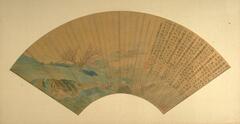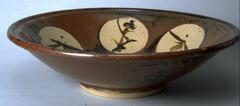10 Items in this Learning Collection
Collection Object
Collection Object
Collection Object
Collection Object
Collection Object
Collection Object
Collection Object
Collection Object
Collection Object
Collection Object
Copyright
All Rights Reserved
()
Courtesan in procession
Accession Number
1962/1.104
Title
Courtesan in procession
Artist(s)
Kitagawa Utamaro
Artist Nationality
Japanese (culture or style)
Object Creation Date
circa 1793-1795
Medium & Support
ink, white pigment, and red color on paper
Dimensions
33 3/4 in x 10 9/16 in (85.7 cm x 26.8 cm);33 15/16 in x 10 1/2 in (86.2 cm x 26.7 cm);x 17 1/8 in x 43.5 cm;4 7/16 in x 19 7/8 in x 4 7/16 in (11.2 cm x 50.5 cm x 11.2 cm)
Credit Line
Museum purchase made possible by the Margaret Watson Parker Art Collection Fund
Label copy
In the 1790s, Kitagawa Utamaro was without peer in Edo as a master of images of beautiful women. Santô Kyôden was a wildly successful writer of satirical fiction. Both were in the stable of the astute publisher Tsutaya Jûzaburô, and all three were infamous for whiling away their days in the teahouses of Yoshiwara, the licensed pleasure district. This painting is perhaps the most beautiful work of art to result from their collaboration.
Utamaro evokes for us the haunting beauty of a young courtesan—probably Hanaôgi of the Ôgiya—on the day of her formal debut, as she promenades under the cherry blossoms on Yoshiwara’s main avenue, a child attendant in tow. The promenade was an annual ritual in which Yoshiwara’s denizens stepped out in their finest robes to display their beauty and fine taste. Utamaro has chosen a subtle palette of white, black, and shades of gray, which captures our attention all the more for being unexpected. The only color comes from the dazzling brocade that frames the painting, a fragment of a kimono that is original to the work.
The poems, in Santô Kyôden’s hand, may be loosely translated as:
The gold of her ransom may be measured
in the chrysanthemum dew from the Sweet Valley,
but the celebratory cup of her debut
is drawn from pure saké of the Sumida River.
It may be that even Saigyô never saw such flowers as these—
Yoshiwara in bloom.
(Label for UMMA Japanese Gallery Opening Rotation, March 2009)
Subject matter
Utamaro evokes for us the haunting beauty of a young courtesan— probably Hanaôgi of the Ôgiya—on the day of her formal debut, as she promenades under the cherry blossoms on Yoshiwara’s main avenue, with a child attendant in tow. The promenade was an annual ritual where Yoshiwara’s denizens stepped out in their finest robes to display their beauty and fine taste. Utamaro has chosen a subtle palette of white, black, and shades of gray, which captures our attention all the more for being unexpected. The only color comes from the red lips of the two and the dazzling brocade that frames the painting, a fragment of a courtesan’s kimono that is original to the work. It is tempting to think that it belonged to Hanaôgi, and thus completes her portrait.
Physical Description
This is a portrait of courtesan and her attendant. The courtesan wears a kimono with overall cherry blossom patterns and a darker color cloak with fan, plover and wave design lining with overall cherry blossom design silk; the cloak is slipping from her right shoulder. Her obi is draped in front; it has overall hollyhock pattern. Her face is white; Her hair is sculpted like a balloon on the top and has broad wings to the side. Tortoise-shell comb and multiple hairpins adorn the hair. She is strolling toward the right. Her attendant is walking behind her, her face and body partially hidden by the courtesan. She wears the matching kimono with plover and wave design; her kimono has long sleeves (furisode), whose openings are tied with ribbons. Her obi, with peony and geometric design, is tied at the back. Her hair is in the similar shape as the courtesan but not too exaggerated. But she wears an enormous hair accessory consisting of cherry blossoms and tassels, made of silver. Her face is also in white. The painting is accompanied by poem written by Santô Kyôden with his signature and two seals. On the lower left, there are the artist's signature and seal. The mounting is made of silk brocade with embroidery in the design of clematis and millets.
Primary Object Classification
Painting
Primary Object Type
hanging scroll
Additional Object Classification(s)
Painting
Collection Area
Asian
Rights
If you are interested in using an image for a publication, please visit http://umma.umich.edu/request-image for more information and to fill out the online Image Rights and Reproductions Request Form.
Keywords
calligraphy (process)
children (people by age group)
courtesans
kimonos
literary theory
1962/1.104
Title
Courtesan in procession
Artist(s)
Kitagawa Utamaro
Artist Nationality
Japanese (culture or style)
Object Creation Date
circa 1793-1795
Medium & Support
ink, white pigment, and red color on paper
Dimensions
33 3/4 in x 10 9/16 in (85.7 cm x 26.8 cm);33 15/16 in x 10 1/2 in (86.2 cm x 26.7 cm);x 17 1/8 in x 43.5 cm;4 7/16 in x 19 7/8 in x 4 7/16 in (11.2 cm x 50.5 cm x 11.2 cm)
Credit Line
Museum purchase made possible by the Margaret Watson Parker Art Collection Fund
Label copy
In the 1790s, Kitagawa Utamaro was without peer in Edo as a master of images of beautiful women. Santô Kyôden was a wildly successful writer of satirical fiction. Both were in the stable of the astute publisher Tsutaya Jûzaburô, and all three were infamous for whiling away their days in the teahouses of Yoshiwara, the licensed pleasure district. This painting is perhaps the most beautiful work of art to result from their collaboration.
Utamaro evokes for us the haunting beauty of a young courtesan—probably Hanaôgi of the Ôgiya—on the day of her formal debut, as she promenades under the cherry blossoms on Yoshiwara’s main avenue, a child attendant in tow. The promenade was an annual ritual in which Yoshiwara’s denizens stepped out in their finest robes to display their beauty and fine taste. Utamaro has chosen a subtle palette of white, black, and shades of gray, which captures our attention all the more for being unexpected. The only color comes from the dazzling brocade that frames the painting, a fragment of a kimono that is original to the work.
The poems, in Santô Kyôden’s hand, may be loosely translated as:
The gold of her ransom may be measured
in the chrysanthemum dew from the Sweet Valley,
but the celebratory cup of her debut
is drawn from pure saké of the Sumida River.
It may be that even Saigyô never saw such flowers as these—
Yoshiwara in bloom.
(Label for UMMA Japanese Gallery Opening Rotation, March 2009)
Subject matter
Utamaro evokes for us the haunting beauty of a young courtesan— probably Hanaôgi of the Ôgiya—on the day of her formal debut, as she promenades under the cherry blossoms on Yoshiwara’s main avenue, with a child attendant in tow. The promenade was an annual ritual where Yoshiwara’s denizens stepped out in their finest robes to display their beauty and fine taste. Utamaro has chosen a subtle palette of white, black, and shades of gray, which captures our attention all the more for being unexpected. The only color comes from the red lips of the two and the dazzling brocade that frames the painting, a fragment of a courtesan’s kimono that is original to the work. It is tempting to think that it belonged to Hanaôgi, and thus completes her portrait.
Physical Description
This is a portrait of courtesan and her attendant. The courtesan wears a kimono with overall cherry blossom patterns and a darker color cloak with fan, plover and wave design lining with overall cherry blossom design silk; the cloak is slipping from her right shoulder. Her obi is draped in front; it has overall hollyhock pattern. Her face is white; Her hair is sculpted like a balloon on the top and has broad wings to the side. Tortoise-shell comb and multiple hairpins adorn the hair. She is strolling toward the right. Her attendant is walking behind her, her face and body partially hidden by the courtesan. She wears the matching kimono with plover and wave design; her kimono has long sleeves (furisode), whose openings are tied with ribbons. Her obi, with peony and geometric design, is tied at the back. Her hair is in the similar shape as the courtesan but not too exaggerated. But she wears an enormous hair accessory consisting of cherry blossoms and tassels, made of silver. Her face is also in white. The painting is accompanied by poem written by Santô Kyôden with his signature and two seals. On the lower left, there are the artist's signature and seal. The mounting is made of silk brocade with embroidery in the design of clematis and millets.
Primary Object Classification
Painting
Primary Object Type
hanging scroll
Additional Object Classification(s)
Painting
Collection Area
Asian
Rights
If you are interested in using an image for a publication, please visit http://umma.umich.edu/request-image for more information and to fill out the online Image Rights and Reproductions Request Form.
Keywords
calligraphy (process)
children (people by age group)
courtesans
kimonos
literary theory










